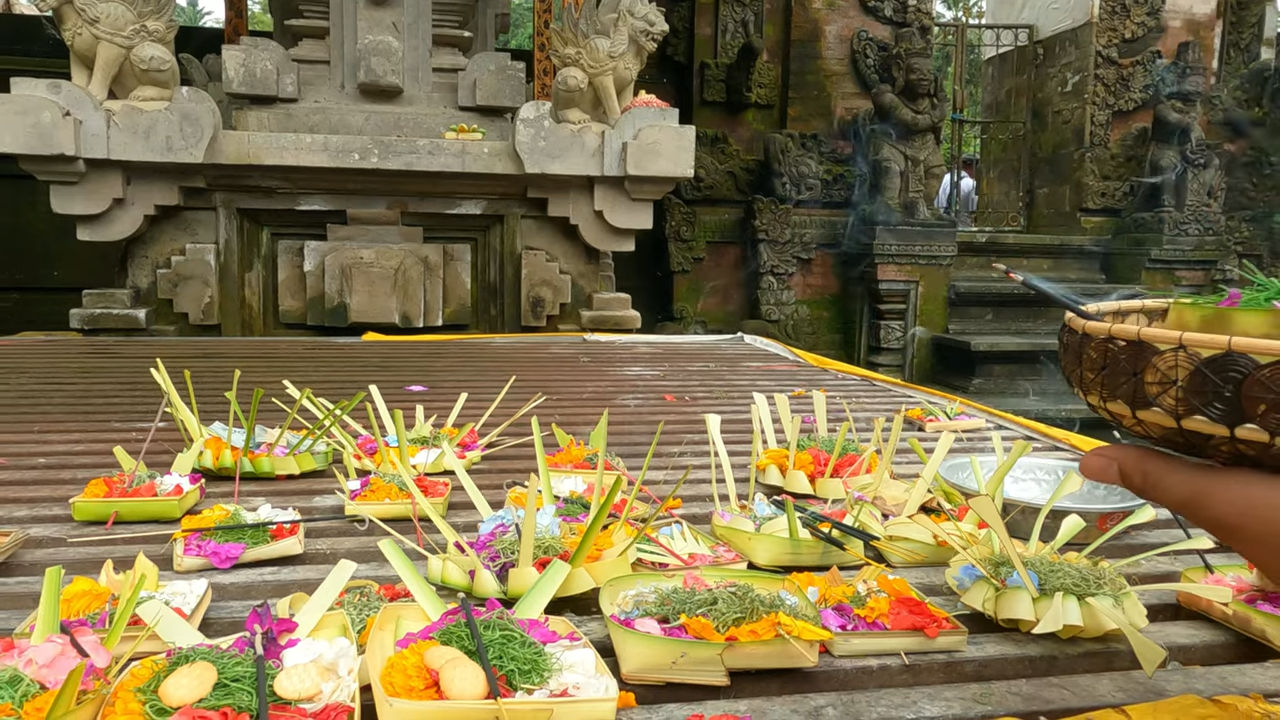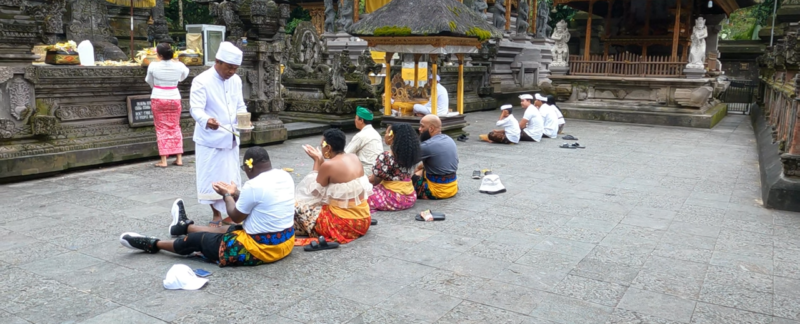Tirta Empul Temple, also known as Pura Tirta Empul, is one of Bali’s most significant and revered Hindu temples. Nestled in the village of Tampaksiring, this sacred site has been a center of worship and pilgrimage for centuries. The temple’s name, “Tirta Empul,” means “holy water spring” in Balinese, and it reflects the primary attraction of the temple: a natural spring that is believed to possess purifying properties. With a rich history, unique architecture, and profound spiritual significance, Tirta Empul Temple is a must-visit destination for those seeking to explore the spiritual and cultural heritage of Bali.
Page Contents
Tirta Empul Temple Video
Tirta Empul Fee
- Foreign Visitor (Adult): 50,000 IDR or $3 USD
- Foreign Visitor (Kid age 5-11): 25000 IDR or $1.5 USD
- Sarong rental: 15000 IDR or $1 USD
- Locker rental: 20000 IDR or $1.5 USD
Tirta Empul Dress Code
First and foremost, it’s important to dress respectfully when visiting any temple in Bali. For Tirta Empul, the dress code is quite simple. You’ll need to wear a traditional Kamen wrap or sarong around your lower body, along with a sash around your waist. These can be rented for a small donation at the entrance to the temple.
If you’re planning on doing the bathing ritual, make sure to bring another sarong or a piece of clothing to change into after the bath. It’s important to respect the local customs and dress appropriately for the sacred nature of the temple.
Tirta Empul Temple Complex
Tirta Empul is a fairly large temple complex, and it takes at least 30 minutes to an hour to visit the entire temple. So, make sure to plan your visit accordingly and give yourself enough time to explore and take in the beauty of the temple.
Outer courtyard with Candi Bentar
The outer courtyard welcomes visitors and is adorned with a variety of statues and shrines. This area is less sacred and is where tourists often take in the initial impressions of the temple.

As soon as you enter a Balinese temple, you’ll walk through a large stone gate known as the Candi Bentar. This gate is an important symbol in Balinese culture and represents the division between the outer world and the inner world of the temple. Once you pass through the Candi Bentar, you’ll arrive in the outer courtyard of the temple. This is the first part of the temple that we’ll be visiting today.
One important feature you’ll notice throughout the temple is the Candi Bentar gates, which are guarded by huge statues of two Dwarapala or guardians. These statues are an important symbol in Balinese culture and represent the balance of good and evil.
Middle courtyard
Next, we’ll move on to the middle courtyard of the temple. Here we are going to pray to lord Vishnu first before going inside the water. After visiting the middle courtyard, we’ll move on to one of the most important parts of the temple – the holy springs.
Holy Spring
This is where devotees come to take a bath and cleanse themselves spiritually. We’ll also take a dip in the holy springs and feel the purifying power of the water. This temple has holy springs that are said to have been created by the God Indra and are believed to be blessed water that can purify those who bathe there. The temple is dedicated to Vishnu, and it’s considered one of the five most holy temples in Bali.

The holy springs flow here through 30 water spouts into two pools, each having 15 water spouts. Worshippers stand in lines to take a dip in the holy water. The cleansing process starts from the pool on the left side. Once they have cleansed themselves under the first spout, they join the next queue. This process continues until they have cleansed themselves under each water spout.
However, two spouts are meant only for cleansing the dead and are prohibited to be used by the living. Although it is a sacred place of worship for the locals, tourists from all over the world are welcome here. In 2017, former US President Barack Obama & family also came here.
After taking the holy bath, we will change our clothes and go the main temple to worship. In most of the main temples here, the worship is led by the main priest who sits at the front, and devotees follow him. There is a particular order in which the worship is done.
Main temple in inner courtyard
Finally, we’ll move on to the main temple. This is the heart of the temple and is usually where the main deity is worshipped. We’ll offer our final worship here and take in the peaceful and serene atmosphere. Tirta Empul Temple features numerous shrines and statues dedicated to various deities in the Hindu pantheon. Some of the most prominent ones include:
- a. The central shrine (meru) is dedicated to the god Vishnu. It is a towering, multi-tiered structure that serves as the most sacred spot in the temple complex.
- b. Other shrines are dedicated to gods like Shiva, Brahma, and Ganesh, representing the trimurti of the Hindu faith.
- c. The temple is adorned with intricate stone carvings that depict scenes from Hindu epics like the Ramayana and Mahabharata. These carvings are a testament to the exquisite craftsmanship of Balinese artists.

Offering / Canang
Canang, the traditional offering to God in Bali, is an important part of this entire journey. Canang is a beautiful offering made up of four different flowers of different colors along with rice, also known as wija locally. The flowers symbolize peace, while the rice symbolizes Atma or the spirit that gives life to the universe. Usually, Balinese people prepare Canang at their home or buy it from the shops.
Before the prayer, agarbati or scented sticks are used for purification. These sticks are known for their cleansing and soothing aroma, which is why they are used to purify the surroundings before prayer. Canang is an essential offering in Balinese Hindu culture, and it is believed that offering Canang to God brings peace, harmony, and positivity in one’s life.

Tirta Empul Temple Story
Tirta Empul Temple dates back to the 10th century during the Warmadewa dynasty rule. The Balinese king, Mayadenawa, who reigned during this period, is an important figure in the temple’s history. According to the Balinese legend, King Mayadenawa was a powerful and arrogant ruler who practiced black magic and sought to undermine Hinduism in Bali. His defiance of Hinduism led to a conflict with the god Indra, who subsequently sent an army of holy warriors to defeat him.
During this legendary battle, Mayadenawa created a poisoned spring, the source of the Pakerisan River, which caused Indra’s warriors to fall ill. In response, Indra pierced the earth, creating a sacred spring at Tirta Empul. The holy water from this spring restored the warriors to health and gave them the strength to defeat Mayadenawa. The temple was then established to commemorate this victory and the life-giving waters of the spring.
Tirta Empul Cultural Significance
Spiritual Rejuvenation
Tirta Empul Temple is a place of profound spiritual significance for the Balinese people. The holy spring represents a source of spiritual rejuvenation and purification. It is believed that by immersing oneself in the sacred waters, an individual can cleanse themselves of impurities and negative energies.
Balinese Hinduism
The temple plays a crucial role in the practice of Balinese Hinduism, which is a unique blend of Hinduism, animism, and indigenous Balinese beliefs. Balinese Hindus visit the temple regularly for purification rituals and to offer prayers and offerings to their deities.
Pilgrimage Destination
Tirta Empul Temple is a prominent pilgrimage destination for Balinese Hindus. Many Balinese people make the journey to Tampaksiring to partake in rituals and ceremonies that involve the holy spring. Pilgrims often come with their families, adding a strong sense of community to the temple’s atmosphere.
Tourist Attraction
Tirta Empul Temple is also a significant tourist attraction in Bali. Its unique blend of spirituality, natural beauty, and historical significance draws visitors from around the world. The temple’s accessible location makes it a popular stop for tourists exploring Bali’s cultural heritage.

